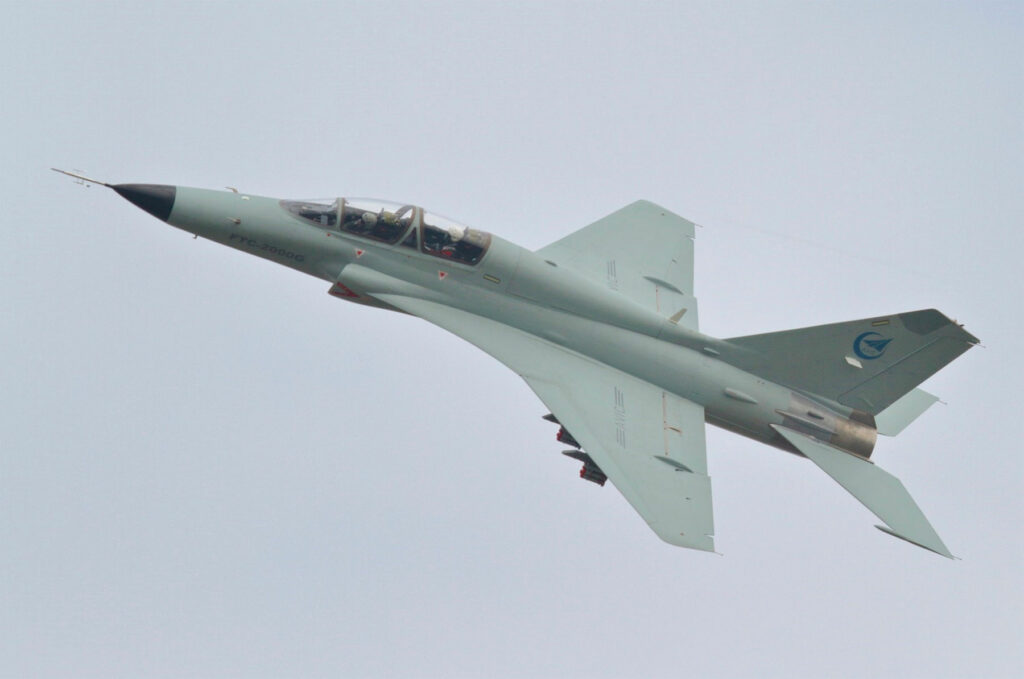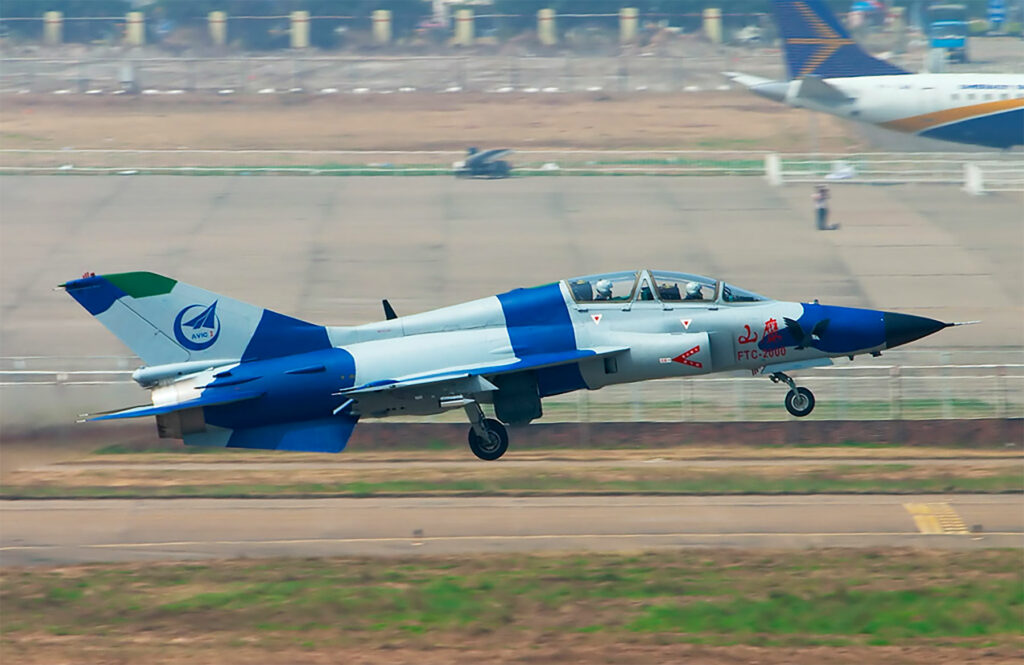The Guizhou JL-9 Shanying (FTC-2000 Mountain Eagle) is a Chinese two-seat, supersonic advanced jet trainer and light attack aircraft developed for the People’s Liberation Army Air Force (PLAAF) and Naval Air Force (PLANAF).
The Guizhou JL-9, also known as the FTC-2000 Mountain Eagle, is a Chinese two-seat, supersonic advanced jet trainer and light attack aircraft. Developed by the Guizhou Aviation Industry Corporation (GAIC), it serves both the People’s Liberation Army Air Force (PLAAF) and the People’s Liberation Army Naval Air Force (PLANAF). The aircraft features a length of 14.555 meters (47.75 feet), a wingspan of 8.32 meters (27.3 feet), and a height of 4.105 meters (13.47 feet). Powered by a single Guizhou Liyang WP-13F(C) turbojet engine with afterburner, it achieves a maximum speed of Mach 1.5 and operates at altitudes up to 16,000 meters (52,493 feet). The JL-9 is equipped with a 23mm internal cannon and can carry up to 2,000 kilograms (4,409 pounds) of external ordnance across five hardpoints. Its design emphasizes cost-effectiveness and ease of maintenance, making it a practical solution for advanced pilot training and light combat roles.

History of Development
In the early 2000s, the People’s Liberation Army Air Force (PLAAF) identified a need for an advanced jet trainer to prepare pilots for fourth-generation fighters like the Chengdu J-10 and the Shenyang J-11. Existing trainers, such as the JJ-7—a derivative of the MiG-21—were becoming outdated and lacked the capabilities required for modern combat aircraft training. To address this gap, the Guizhou Aviation Industry Corporation (GAIC) initiated the development of a new trainer aircraft.
Leveraging its experience with the JJ-7, GAIC embarked on designing an aircraft that would be both cost-effective and capable of providing advanced training. The project aimed to create a platform that could simulate the performance characteristics of modern fighters, thereby reducing the learning curve for pilots transitioning to frontline aircraft.
The development program commenced in the early 2000s, with the first prototype taking to the skies on December 13, 2003. The aircraft was designated JL-9 for domestic use and FTC-2000 for the export market. The name “Shanying,” meaning “Mountain Eagle,” was chosen to symbolize agility and strength.
The JL-9’s design incorporated elements from the JJ-7, such as the empennage and mechanical controls, while introducing significant advancements. Notably, it featured a new wing design, a forward fuselage with side air intakes, and a glass cockpit. These enhancements aimed to provide a training environment more representative of modern combat aircraft.
In 2011, recognizing the need for carrier-based pilot training, GAIC developed a naval variant known as the JL-9G. This version included modifications such as strengthened landing gear and a tailhook to simulate carrier landings, catering to the training requirements of the People’s Liberation Army Naval Air Force (PLANAF).
The JL-9 entered service with the PLANAF in 2014, followed by the PLAAF in 2015. Its introduction marked a significant step in modernizing China’s pilot training programs, providing a seamless transition for pilots moving to advanced fighter jets.
The aircraft’s export variant, the FTC-2000, garnered interest from international customers seeking affordable advanced training solutions. In 2018, Sudan became the first export customer, receiving several units to enhance its air force’s training capabilities.
Throughout its development, the JL-9 program faced challenges, including competition from other domestic trainers like the Hongdu JL-10. However, its cost-effectiveness and the incorporation of proven technologies contributed to its adoption by both domestic and international operators.
As of 2024, the JL-9 continues to serve as a vital component of China’s military aviation training infrastructure, reflecting the country’s commitment to developing indigenous defense technologies and capabilities.
Design
The Guizhou JL-9 Shanying is a two-seat, supersonic advanced jet trainer and light attack aircraft, designed to provide a seamless transition for pilots advancing to fourth-generation fighter jets. Its design integrates elements from previous aircraft while incorporating modern features to meet contemporary training and operational requirements.
Airframe and Dimensions:
- Length: 14.555 meters (47.75 feet)
- Wingspan: 8.32 meters (27.3 feet)
- Height: 4.105 meters (13.47 feet)
- Wing Area: 24.165 square meters (260 square feet)
The JL-9’s airframe is constructed primarily from aluminum alloys, providing a balance between structural integrity and weight efficiency. The aircraft features a high-mounted wing with a slight sweep, contributing to its aerodynamic performance and stability at various speeds.
Cockpit:
The tandem-seat cockpit is equipped with modern avionics, including a glass cockpit layout featuring multifunction displays (MFDs), a head-up display (HUD), and hands-on throttle and stick (HOTAS) controls. This setup mirrors the interface of contemporary fighter aircraft, facilitating an effective training environment. Both seats are fitted with ejection systems, ensuring pilot safety in emergency situations.
Engine and Propulsion:
The JL-9 is powered by a single Guizhou Liyang WP-13F(C) turbojet engine with afterburner, producing a maximum thrust of 43. kN (9,670 pounds). This engine, derived from earlier Chinese turbojet designs, provides sufficient power for supersonic flight and maneuverability during training and combat scenarios. The afterburner boosts thrust, allowing the aircraft to reach speeds of up to Mach 1.5.
Landing Gear and Structural Features:
The aircraft is equipped with a tricycle landing gear configuration, ensuring stability during taxiing, takeoff, and landing. The gear is reinforced for rugged operational environments, with the naval variant (JL-9G) featuring strengthened landing gear and a tailhook for carrier-based training.
Weapons and Hardpoints:
The JL-9 has five external hardpoints—one under the fuselage and two under each wing—capable of carrying a total payload of 2,000 kilograms (4,409 pounds). Its weaponry includes:
- 23mm internal cannon: For close-range engagement and training.
- Air-to-air missiles: Such as the PL-5 and PL-7, for dogfight training.
- Unguided rockets and bombs: For ground attack roles.
- Precision-guided munitions: Available for light attack operations.
Advantages and Drawbacks:
Advantages:
- Cost-effective solution for advanced pilot training.
- Supersonic capabilities allow for realistic training scenarios.
- Modular design enables adaptation for combat roles.
Drawbacks:
- Relatively dated engine design compared to competitors.
- Limited payload capacity for extensive combat missions.
- Competes with more advanced trainers like the Hongdu JL-10.
Performance
The Guizhou JL-9 Shanying offers reliable performance as a supersonic jet trainer and light attack aircraft, designed to meet the demands of modern pilot training and secondary combat roles.
Specifications:
- Engine: Guizhou Liyang WP-13F(C) turbojet with afterburner.
- Maximum Speed: Mach 1.5 (1,800 km/h or 1,118 mph).
- Service Ceiling: 16,000 meters (52,493 feet).
- Range: 850 kilometers (528 miles) without external fuel tanks.
- Combat Radius: Approximately 550 kilometers (342 miles).
- Rate of Climb: 150 meters per second (492 feet per second).
Supersonic Capability:
With a top speed of Mach 1.5, the JL-9 provides a realistic training environment for pilots transitioning to supersonic fighters. Its supersonic capability allows pilots to practice high-speed maneuvers, weapon delivery, and intercept training.
Endurance and Range:
The JL-9’s range of 850 kilometers without external fuel tanks is suitable for training missions and limited combat operations. With external fuel tanks, its range can be extended, making it versatile for longer missions.
Maneuverability:
The aircraft’s aerodynamic design and engine thrust allow for high agility, making it effective for dogfight training and close air support. Its rate of climb ensures rapid altitude changes during intercept missions or evasive maneuvers.
Payload Versatility:
The JL-9’s hardpoints support a mix of munitions, enabling it to switch between training and combat configurations. Its ability to carry precision-guided munitions adds value in light attack roles.
Comparison to Competitors:
The JL-9 competes with aircraft like the Hongdu JL-10 and KAI T-50 Golden Eagle. While the JL-10 features a more modern design and avionics, the JL-9’s cost-effectiveness and operational simplicity make it a practical choice for budget-conscious operators. The KAI T-50 offers superior speed and avionics but at a significantly higher cost.
Operational Applications:
The JL-9 is widely used for pilot training in supersonic flight, weapon systems operation, and combat tactics. Its dual-role capability allows it to function effectively in secondary combat missions, particularly in asymmetric warfare scenarios.

Variants of the Guizhou (AVIC) JL-9 Shanying
- JL-9 (Baseline Model):
- Standard advanced trainer for the PLAAF.
- Optimized for transition training to fourth-generation fighters.
- JL-9G (Naval Variant):
- Developed for PLANAF, featuring strengthened landing gear and a tailhook.
- Designed for carrier-based pilot training and operations on shorter runways.
- FTC-2000 (Export Variant):
- Simplified version marketed internationally.
- Tailored to meet the requirements of export customers, with options for customized avionics and payload configurations.
- FTC-2000G (Armed Export Variant):
- Enhanced version with a focus on light attack missions.
- Increased payload capacity and upgraded avionics for combat roles.
Military Use and Combat
Armament and Mission Capabilities:
The JL-9 is equipped with a 23mm internal cannon and can carry a variety of munitions across five hardpoints, including air-to-air missiles, unguided bombs, and precision-guided munitions. Its flexibility allows it to switch seamlessly between training and combat roles.
Training Role:
The JL-9 is primarily used for advanced pilot training, simulating the performance of modern fourth-generation fighters. It enables pilots to practice supersonic flight, combat maneuvers, and weapon deployment in a controlled environment.
Combat Operations:
While its primary role is training, the JL-9 has been deployed in light attack missions, particularly in scenarios requiring precision strikes against ground targets. Its ability to carry guided munitions enhances its effectiveness in these roles.
Examples of Deployment:
- Domestic Use: The PLAAF and PLANAF employ the JL-9 extensively for training purposes, preparing pilots for aircraft like the Chengdu J-10 and Shenyang J-11.
- Export Success: Sudan, the first export customer, uses the FTC-2000 for both training and combat missions, highlighting its versatility.
Competitive Landscape:
The JL-9 competes with advanced trainers like the JL-10, KAI T-50, and Yak-130. While it lacks the advanced features of these aircraft, its affordability and simplicity make it an attractive option for nations with limited defense budgets.
Current Status:
The JL-9 remains in active service, with continuous production for domestic and international customers. Its development underscores China’s focus on self-reliance in military aviation and its growing presence in the global defense market.
Back to the Fighter Jet section.